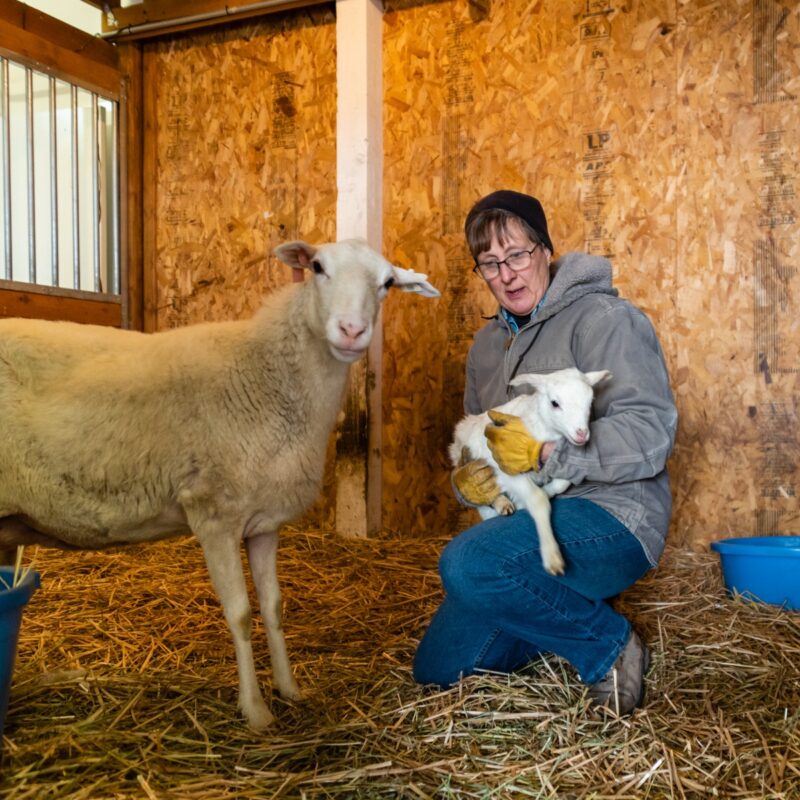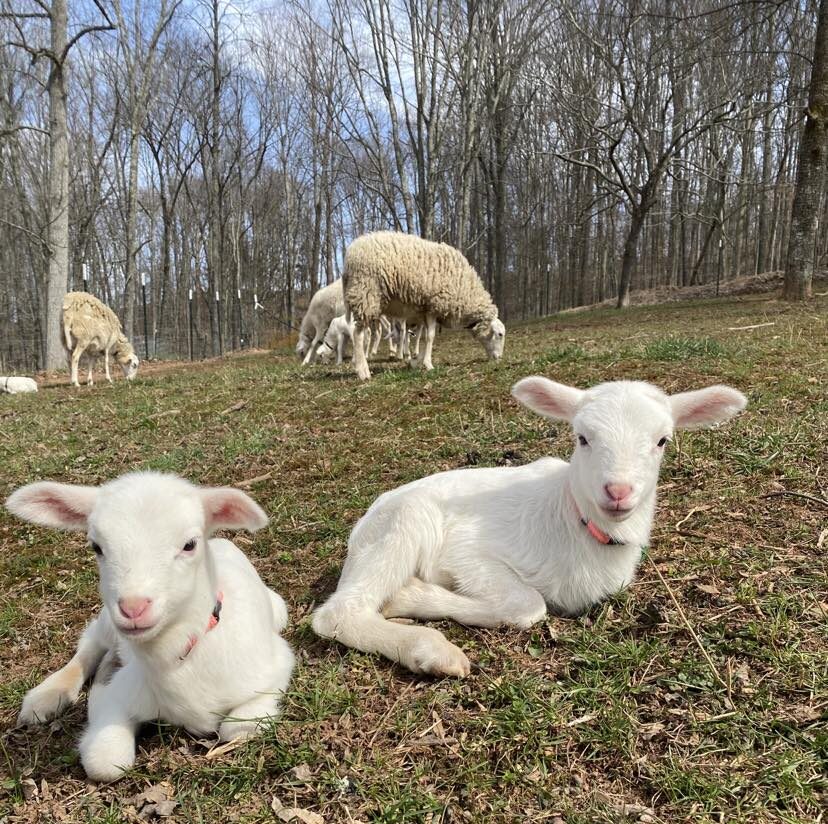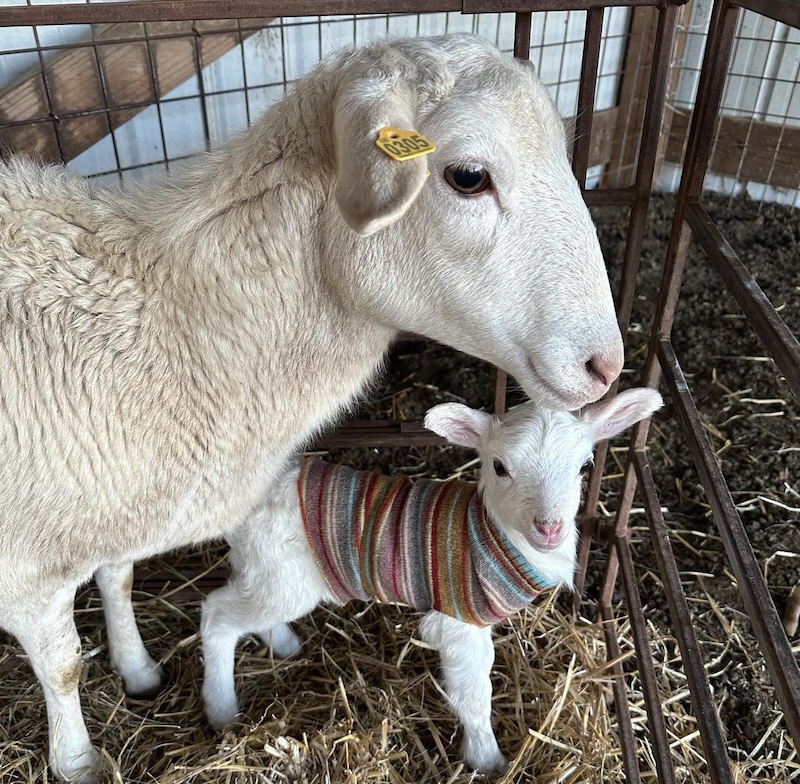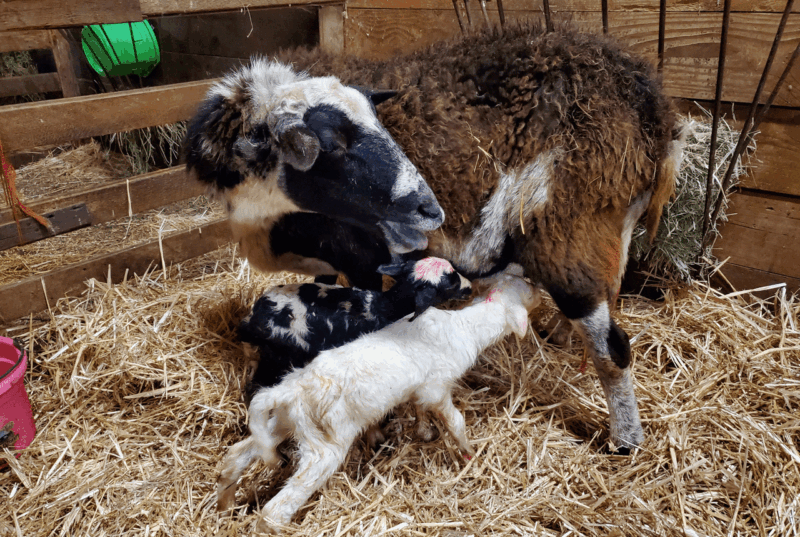I often get questions about my barn and lambing pens setup here at Melwood Farm. I remember when I started with sheep several years ago, I had lots of questions too! This post should help explain how I choose to manage lambing season.
The Barn
The barn is 32 feet long and 24 feet wide. If you want to build a barn, trust me on this: make it bigger than you think you will need! I added a 16-foot open lean-to attached to one long side, under which I installed our chute and tilt table. The front sliding door is 8′ wide, and the back sliding door is 4′ wide. There is a man door on one long side between the barn wall and lean-to. The floor is about 3 inches of lime sand, which is an excellent material for a sheep barn. It drains well while creating a semi-solid surface that is good for their feet. Cleanup is a breeze using a rake to pull soiled bedding to a pile, then scoop it into the wheelbarrow or tractor front loader to take to the compost heap.
I sectioned off one 8×32 side of the interior using livestock panels, a 3′ walk-thru gate, and a homemade 8′ hay feeder. This area is great for storing square bales of hay and straw, various feeds, and a cabinet for medications, supplements, and tools.
In previous years, I fed hay inside the barn using the 8′ hay feeder and by placing a round bale in one corner of the barn. I have since discontinued this practice because the ewes spent a lot of time inside the barn. I now feed hay outside in either the barnyard/sacrifice paddock or as part of a bale grazing system on a targeted paddock using a collapsible bale feeder.
The Lambing Pens
On the opposite side of the barn, I have seven lambing pens, sometimes called jugs or bonding pens. I set them up well before lambing begins so they are ready to use and stay clean. Until this year, all but two of the jugs were 4′ x 4′, which is a good size for an average St. Croix ewe and her single or twin lambs. However, about half my ewes are in the habit of producing triplets, so the two jugs that I had reserved for this purpose at 4′ x 6′ are insufficient. My jugs are now 4’x5′, with two still at 4’x6′. I use the two largest jugs for my Katahdin and crossbred ewes or any that need penned for longer than 48 hours.
The pens can be constructed from cut pieces of sheep panels, which have 4″ x 4″ openings rather than the larger openings on standard livestock panels. If sticking with the 4’x4′ jugs, cut each 16′ x 4′ panel into 3′ lengths. Using screw eyes and wire or twine, attach the side panels to the wallboards of the barn. You can create gate hinges using these wire panel connector hinges and use spring snap carabiners to lock the gates closed. Another option is to build jug panels out of 1″x4″ lumber so that you can make them the size you wish.
Each pen has a flat-backed water bucket, a feed tray, and a hay-bag. I prefer straw over other bedding materials. It is easy to clean out and keeps the lambs warmer than shavings or crushed cob. The pens aren’t fancy, but they do get the job done!
How I Use the Barn and Pens
My sheep have access to the barn and lean-to during the winter months and lambing season, and can enter and leave as they wish. They rarely have access to the barn outside of winter months, except when I’m sorting, weaning, or performing other flock work. During lambing seasons, I do not keep the expecting ewes or new families locked in the barn. The ewes lamb on pasture with only a few that choose to enter the barn to do so. Outside of lambing season, I store the panels by hanging them on hooks in the barn.
How I Move the New Family into the Lambing Pens
Some may wonder how to get the ewe and newborn lambs into a pen if they lamb outside. After the ewe cleans and nurses the newborn lambs, I bring them into a lambing jug. I wait for her to clean and nurse to reduce the chances of interrupting the bonding process and to keep most of the birthing mess outside the barn. Most ewes are easy to bring in by picking up the lambs, carrying them low at my sides, and walking slowly to the pen. The ewe follows her lambs in most cases. Sometimes, nervous ewes take a bit more finesse, but the process is much the same. If the ewe gets confused and wanders away, I just set the lambs down for a moment. They cry out, and the ewe comes running back to sniff them. I then resume the trip to the barn.
How Long do They Stay in the Pens?
Most new families stay in the pen for 24 hours or less, but at least overnight. The morning/day after the birth, I weigh, tag, and record the new lambs. This part of the process is vital to measuring performance and managing registration records. Time spent in the pen also gives me the opportunity to observe them to make sure the ewe is mothering well and producing enough milk.
I often keep triplets in the pen an extra day because in many cases, one of the lambs is smaller than the other two. That smaller lamb often needs an extra day to build up strength to keep up with its larger siblings. That extra day also helps me determine if the ewe can produce enough milk for all three lambs. If in doubt, I keep them in a bit longer to supplement with bottle feeding and then decide whether or not to pull one of the lambs.
Does Everyone Need a Barn and Lambing Pens?
Not everyone uses a barn or lambing pens. In fact, I didn’t have a barn for my first two lambing seasons and made it through! Some have very small flocks (as I once did) so it’s easy to keep up with who is who. I had a rough time catching little lambs only a few days old to tag them in my first year, so jugging the families immediately works best for me.
Some have extra help, are quick to catch newborn lambs and perform all their tagging and record keeping on the pasture, or are skilled at sorting families later. Others don’t do any record keeping because pedigrees and individual record keeping are unimportant in their model.
Having a barn available allows me to lamb in winter months. If I didn’t have a barn, I would limit lambing to April-November to avoid lamb hypothermia. Many producers choose the lower input approach of lambing only in warm seasons on pasture, and never need a barn. Whichever method you choose, just remember that your management style needs to align with your budget, environment, and flock goals.






